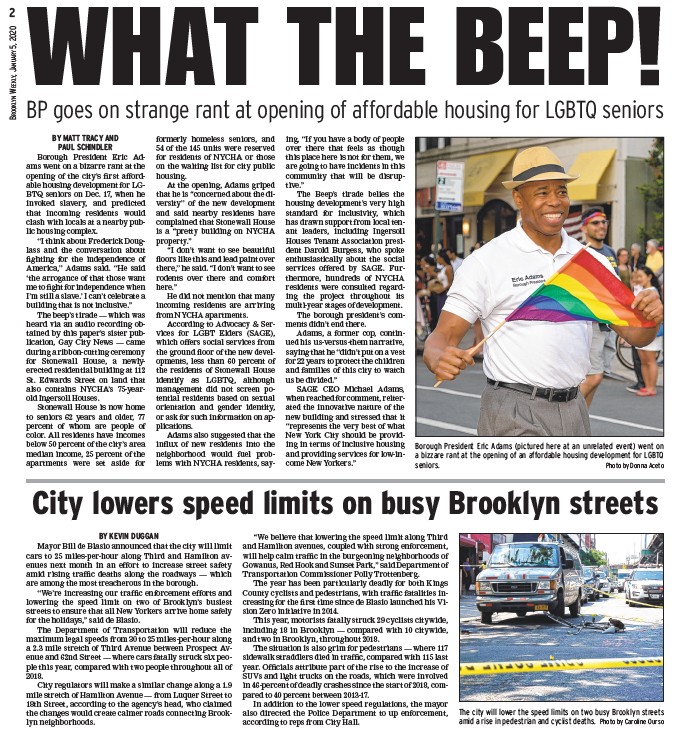
2
BROOKLYN WEEKLY, JANUARY 5, 2020
WHAT THE BEEP!
BP goes on strange rant at opening of affordable housing for LGBTQ seniors
BY MATT TRACY AND
PAUL SCHINDLER
Borough President Eric Adams
went on a bizarre rant at the
opening of the city’s fi rst affordable
housing development for LGBTQ
seniors on Dec. 17, when he
invoked slavery, and predicted
that incoming residents would
clash with locals at a nearby public
housing complex.
“I think about Frederick Douglass
and the conversation about
fi ghting for the independence of
America,” Adams said. “He said
‘the arrogance of that those want
me to fi ght for independence when
I’m still a slave.’ I can’t celebrate a
building that is not inclusive.”
The beep’s tirade — which was
heard via an audio recording obtained
by this paper’s sister publication,
Gay City News — came
during a ribbon-cutting ceremony
for Stonewall House, a newlyerected
residential building at 112
St. Edwards Street on land that
also contains NYCHA’s 75-yearold
Ingersoll Houses.
Stonewall House is now home
to seniors 62 years and older, 77
percent of whom are people of
color. All residents have incomes
below 50 percent of the city’s area
median income, 25 percent of the
apartments were set aside for
formerly homeless seniors, and
54 of the 145 units were reserved
for residents of NYCHA or those
on the waiting list for city public
housing.
At the opening, Adams griped
that he is “concerned about the diversity”
of the new development
and said nearby residents have
complained that Stonewall House
is a “pretty building on NYCHA
property.”
“I don’t want to see beautiful
fl oors like this and lead paint over
there,” he said. “I don’t want to see
rodents over there and comfort
here.”
He did not mention that many
incoming residents are arriving
from NYCHA apartments.
According to Advocacy & Services
for LGBT Elders (SAGE),
which offers social services from
the ground fl oor of the new developments,
less than 60 percent of
the residents of Stonewall House
identify as LGBTQ, although
management did not screen potential
residents based on sexual
orientation and gender identity,
or ask for such information on applications.
Adams also suggested that the
infl ux of new residents into the
neighborhood would fuel problems
with NYCHA residents, saying,
“If you have a body of people
over there that feels as though
this place here is not for them, we
are going to have incidents in this
community that will be disruptive.”
The Beep’s tirade belies the
housing development’s very high
standard for inclusivity, which
has drawn support from local tenant
leaders, including Ingersoll
Houses Tenant Association president
Darold Burgess, who spoke
enthusiastically about the social
services offered by SAGE. Furthermore,
hundreds of NYCHA
residents were consulted regarding
the project throughout its
multi-year stages of development.
The borough president’s comments
didn’t end there.
Adams, a former cop, continued
his us-versus-them narrative,
saying that he “didn’t put on a vest
for 22 years to protect the children
and families of this city to watch
us be divided.”
SAGE CEO Michael Adams,
when reached for comment, reiterated
the innovative nature of the
new building and stressed that it
“represents the very best of what
New York City should be providing
in terms of inclusive housing
and providing services for low-income
New Yorkers.”
Borough President Eric Adams (pictured here at an unrelated event) went on
a bizzare rant at the opening of an affordable housing development for LGBTQ
seniors. Photo by Donna Aceto
City lowers speed limits on busy Brooklyn streets
BY KEVIN DUGGAN
Mayor Bill de Blasio announced that the city will limit
cars to 25 miles-per-hour along Third and Hamilton avenues
next month in an effort to increase street safety
amid rising traffi c deaths along the roadways — which
are among the most treacherous in the borough.
“We’re increasing our traffi c enforcement efforts and
lowering the speed limit on two of Brooklyn’s busiest
streets to ensure that all New Yorkers arrive home safely
for the holidays,” said de Blasio.
The Department of Transportation will reduce the
maximum legal speeds from 30 to 25 miles-per-hour along
a 2.3 mile stretch of Third Avenue between Prospect Avenue
and 62nd Street — where cars fatally struck six people
this year, compared with two people throughout all of
2018.
City regulators will make a similar change along a 1.9
mile stretch of Hamilton Avenue — from Luquer Street to
18th Street, according to the agency’s head, who claimed
the changes would create calmer roads connecting Brooklyn
neighborhoods.
“We believe that lowering the speed limit along Third
and Hamilton avenues, coupled with strong enforcement,
will help calm traffi c in the burgeoning neighborhoods of
Gowanus, Red Hook and Sunset Park,” said Department of
Transportation Commissioner Polly Trottenberg.
The year has been particularly deadly for both Kings
County cyclists and pedestrians, with traffi c fatalities increasing
for the fi rst time since de Blasio launched his Vision
Zero initiative in 2014.
This year, motorists fatally struck 29 cyclists citywide,
including 18 in Brooklyn — compared with 10 citywide,
and two in Brooklyn, throughout 2018.
The situation is also grim for pedestrians — where 117
sidewalk straddlers died in traffi c, compared with 115 last
year. Offi cials attribute part of the rise to the increase of
SUVs and light trucks on the roads, which were involved
in 46-percent of deadly crashes since the start of 2018, compared
to 40 percent between 2013-17.
In addition to the lower speed regulations, the mayor
also directed the Police Department to up enforcement,
according to reps from City Hall.
The city will lower the speed limits on two busy Brooklyn streets
amid a rise in pedestrian and cyclist deaths. Photo by Caroline Ourso